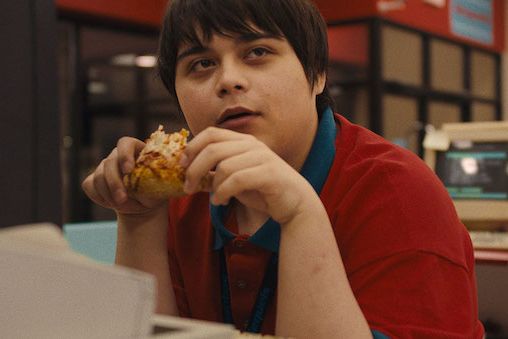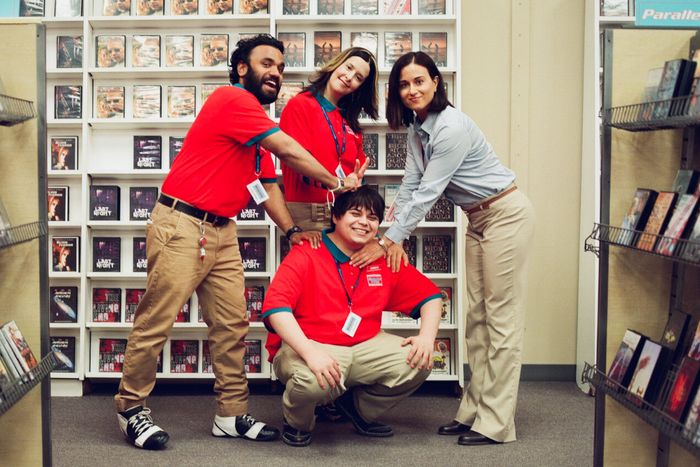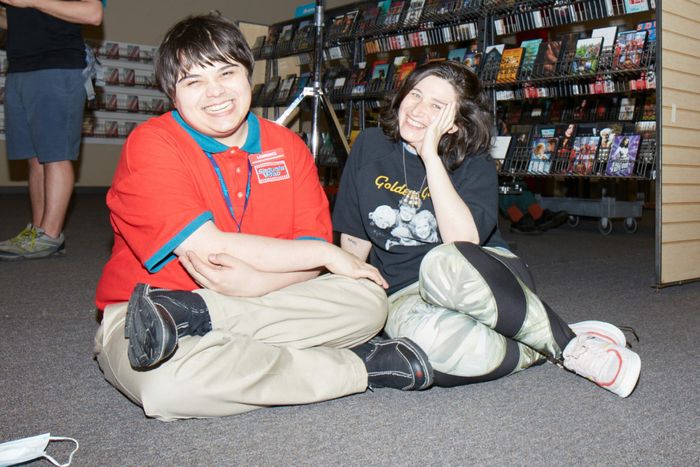A torrented Sum 41 album burned onto a CD in a PT Cruiser. The click of the lid on a VHS cassette rewinder. A DVD cover so scary that you ritualistically avert your eyes when you walk past it at Blockbuster. We used to have physical media we could hold and own, or at least rent. We used to have video stores in every strip mall. We used to be a proper country, and in the darkly comic I Like Movies, that country was Canada. In her first film, writer-director Chandler Levack lovingly re-creates the Greater Toronto Area suburbs of her early-2000s teen years, right down to a fake video store. Coming from a career in film and music journalism, Levack tells the story of teen film geek Lawrence Kweller (Isaiah Lehtinen), who’s like if Jack Black in High Fidelity was an emotionally troubled kid with a Kubrick obsession. The result is a coming-of-age gem, tailor-made for the Letterboxd set, one that will make you want to hug your DVDs tight and think hard on how shitty you were to your mom. After its debut at the 2022 Toronto International Film Festival, the movie that Levack jokingly refers to as “red-pilled Fabelmans” is finally available to buy or rent in the U.S. Levack caught up with Vulture over egg creams and talked about hitting the “maple ceiling” and why she sees this movie as an early intervention for future misogynist fanboys.
This movie is about a kid who needs movies like he needs to breathe, and obviously it’s very personal. What was your relationship to pop culture as a teen?
The way that I imprinted on pop culture as a teenager was so intense. I felt like I was living my life through the TV shows and movies that I consumed. When Joey and Pacey kissed for the first time on Dawson’s Creek, I felt a level of thrill and elation that surpassed any of my own kisses. As a lonely nerd in a suburb, there was something about the way that there were pop-cultural objects, at the last possible time when there was analog technology, that really wove into the fabric of your soul. Like, my relationship to the Strokes’ first album and the works of Paul Thomas Anderson was so primal.
I wanted to make a teen movie that reflected my teen experience, which was just waiting in a parking lot for my mom to pick me up. It’s a teen movie where nothing happens to the protagonist. He doesn’t go to the prom, doesn’t have any realistic love interests. He just has to confront his own narcissism and entitlement. That was kind of my last year of high school. I remember the cultural obsession I had with New York was so intense, too, so I’d be walking down the hall doing some kind of weird manifestation exercise, pretending that I was in the East Village, a place I’d never been. I think a lot of teenagers feel like this, like, No one understands this the way that I understand this. And I think that it’s actually cuter on a 16-year-old boy than it was on my 16-year-old self working at Blockbuster.
It’s rare to see this sort of coming-of-age movie made by a female director about a boy. What made you want to tell that story?
When I was in the early stages of the film, I met with this female filmmaker for advice. And she asked, “Why is this about a boy? It doesn’t make any sense. It’ll be easier for you to get Canadian arts-grant funding if it’s a woman.” But I think changing the gender of your protagonist allows you to be more autobiographical and truthful because of the level of distance that you can have as a filmmaker. Also, the Lady Bird comparisons would have never ended, and might have even hurt the movie.
Because I had been a pop-culture critic since I was 18, my whole professional development and artistic sensibility was funneled through men, whether they were mentors or men whom I’ve dated or tried to impress. I kind of feel bad for some of them. They’re all so twisted and broken and don’t seem to understand how to function in the world, or how to see women as people, and I think it’s because of all the toxic male art that they also consumed. I wondered about what they were like in high school, and had this idea to do some kind of early intervention on them, or set them on a path of healing so they don’t become really awful film critics, or Darren Aronofsky wearing seven scarves. I have so much empathy for them because they’ve affected my life in so many different ways: wanting to be them, wanting to have them love me and validate me and give me affirmation. Then you realize at a certain point that they all used to be these 16-year-olds crying in a video store watching Punch Drunk Love in the back room. That’s an interesting character for me to unpack.

Photo: Monument Releasing
Our protagonist Lawrence’s relationship with his boss at the video store is such a compelling dynamic.
There’s something interesting about this 16-year-old boy who’s so sure of his incredible future, and this 30-year-old woman who has to deal with his shit, and all the ways that they’re mirror images of each other and inflicting trauma on each other. I feel that’s how women have been culturally ingrained, to cede space to Lawrences, especially if you’re a woman in the arts. I think that a lot of a woman’s job is thinking about how men think and feel. In the bulk of my conversations with friends, we’re constantly trying to give men more interiority than maybe they even have and justify their actions. So it makes sense to me that women would be really excellent at writing male characters, because we’re constantly analyzing men’s behavior.
There’s a real gap in representation in terms of women telling stories about men, seeing men at a different angle than they can see themselves. I grew up consuming every coming-of-age movie made by a man. I skipped my frosh week so I could go see Garden State. Now I look back and think, Why was that so important to me? Why wasn’t there a female Garden State?
The movie opens on “Rejects Night,” a video made by Lawrence with his friend, Matt Macarchuck. How did you nail that early 2000s amateur-video aesthetic and comedy?
My dad found the old mini TV camera that I shot movies on in high school, then I found all of these old videotapes. I’d made a bunch of movies with my friends in high school, and it was really amazing to see what a horrible filmmaker I was. “Rejects Night” is like a masterpiece on the Criterion Collection compared to what I was making in high school, but there’s a joy and a very nerdy purity to them. So we were going for that iMovie 3 aesthetic, and also looked to Lonely Island. There’s also a lot of Canadian culture in there. When Swollen Members gave us the rights to their song, I cried.
Speaking of crying, this movie’s very funny, but in the moments where it gets serious, it’s devastating. How did you land on that tone?
I felt like Lawrence was writing the screenplay, and I was just his secretary, taking dictation. I don’t know why, but his voice was so immediately clear to me. I remember writing a scene, and hearing his voice go, “Well yeah, that’s because my dad committed suicide.” And I was like, “What?!” That was shocking, even to me. I was into the idea of someone who’s gone through something really traumatic and that not excusing their behavior, and making this point that you still have to be accountable for your actions. That’s another sad-boy trope: They just won’t take responsibility for their behavior and keep inflicting similar patterns of harm. This movie’s not coddling Lawrence, or propping him up in the way that I think this movie would if it was directed by him.
You had a career as an arts journalist for over a decade before switching over to actually making a movie yourself. How did that change come about?
It was always in the back of my mind ever since I made those terrible films in high school. I had a desire, but I didn’t want to name it. I went to film school at University of Toronto, but my education was so academic and rigorous that it scared me out of thinking that I could ever make films. I just thought, I’m not Godard, or Jane Campion. I was really too scared to even try. But being a critic was a safe enough thing that was adjacent to what I wanted to do. I loved film criticism. I found Pauline Kael and Wesley Morris. And I love Chuck Klosterman, who was another ’90s Gen-X hero of mine. I lived in New York and interned at Spin when I was 20, and there’s a weird, very funny millennial celebrity to being a critic, where your CD reviews get printed out and taped next to the CDs at the record store, and you feel like, Okay, I’m contributing something. But it was a little whisper that got louder and louder until it was a big scream. At that same age that a lot of women feel that their biological clock is ticking and they need to have a baby, it felt like I needed to make a film. So then I needed to figure out, Who is gonna get me pregnant?

Photo: Kate Killet
You had to give birth to Lawrence.
My beautiful son!
What was the casting process like to find this incredible kid?
It was so hard, because he is the movie. He’s in every frame of it. He never stops talking. You need someone who is charismatic and likable and charming enough that you can forgive really odious behavior, but is also enough of an underdog weirdo that you can buy into him. If it’s someone who’s really good-looking and normal, it’s not going to work, and the movie just falls apart. We expect cute, sweet, blank-slate audience surrogate characters from a lot of our teen and YA movies. I needed someone who actually had a considerable amount of edge and volatility to them. So we did this Canada-wide casting search. Gabriel LaBelle from The Fabelmans auditioned.
Sammy Fabelman! Another young cinephile!
My editor saw it and she was like, “Oh my God, Chandler! There’s a panic-attack scene! There’s a year-end senior video!” Both movies came out at the same time, and some people at TIFF did double-bills. I think you have to watch this one first. Or maybe it’s a good Fabelmans chaser. It’s shorter!
But Isaiah got the part.
I watched 100 audition tapes, and it was so weird watching people who were 30 years old and 12 years old all pretending to be Lawrence. Isaiah was one of the last people who auditioned. His tape wasn’t what I was expecting, but it was so much more interesting and complex. There was this sincerity in his voice, and that conviction. I remember my mom watched his tape, and it was the scene where he screams at his mom at the dinner table. She said, “He’s a really great actor. He’s got a star power to him. But he’s too much like you, and people are not gonna like that.”
And I was like, I think he just got the part. When it’s your first feature, and it’s so personal, it’s important that the actor and you have this collaboration where they really feel like they’re the author of the movie. Those are the kinds of movies and performances I was really looking at: Elsie Fisher in Eighth Grade, Jason Schwartzman in Rushmore. Those movies are those actors.
Did you give him homework?
Yeah, they were all movies he hadn’t seen before, because he mostly loves anime. So he watched Ghost World and Rushmore and I made him watch Frances Ha, which he said made him feel scared to be an adult. We watched Shrek together, and the Christmas special, Shrek the Halls. This was all over Zoom in the middle of the pandemic, so the first time we ever met in person was two weeks before we shot, but by then we’d spent hours and hours talking.
Romina D’Ugo, who plays Alana, is also so extraordinary. She was another self-tape, and I wasn’t familiar with her work. She was on the first season of So You Think You Can Dance Canada. I think because she was a dancer, her physicality is so compelling. And I love the two of them together.

Photo: Tom Wood
What has it been like to release this into the world and see people react to it?
I was living with my dad in Burlington for a lot of the making of the film during the pandemic. I was in that nostalgic place where I was already going through stuff from high school and wearing my old gym clothes, then I broke my leg three weeks after we wrapped the movie, so I had to edit the whole movie at home in a cast and crutches. It was a Rear Window Bart Simpson summer for me. My parents had seen little snippets of it, because I was always watching cuts, or my dad would walk by while I was on Zoom with my editor. He told me when he watched it for the first time in its totality, “I thought it was gonna be awful, because it was just this little boy screaming. But there are other scenes, too!” I had never had an experience like that before, of making something so personal, with my own tone and real voice. All of the shorts and music videos I had made felt more like extensions of somebody else. I had written personal essays and criticism, but that’s still not like making a piece of art.
How about screening it for the sorts of film dudes you’re hoping to address?
I’m available to hold any crying men in exchange for any of their Criterion DVDs.
It’s rare that a Canadian movie garners so much buzz and love, but I Like Movies has been selling out in New York. Can you talk about how you made this very Canadian film?
This was made with a grant called Talent to Watch, which is a Telefilms grant for first features. At the time, I got $125,000 CAD from them [around $91,000 USD]. You don’t have to pay it back; there are no strings attached. They don’t even give notes or influence casting. Compared to the U.S. system, where everyone has to entirely self-fund their projects or get random rich people to give you money, it’s kind of amazing that we have support for first-time features. Then I got a Canada Arts Council grant. So it was entirely based on grants. There’s no way I would have been able to make this film, or even have the incentive to do it, without that support. But at the same time, it is weird that our system is entirely based on the Canadian government giving money to artists. What is Canadian art, if the government is deciding what’s valuable?
How so?
I know there’s always been a stigma attached to English Canadian cinema, that it’s inferior, or has an uncanny valley quality, like a facsimile of what an American movie is supposed to be. I don’t see a lot of Canadian movies that feel like they’re intended to be crowd-pleasers. It’s so rare even for Canadians to know that a Canadian movie exists, because there’s no marketing for them. All of these Canadian movies are set up to fail. When I was making this film, I thought, I’m going to be the one Canadian movie that doesn’t fail. And I still can’t get U.S. distribution. There’s such a fractured landscape, and so many barriers. It feels like you’re hitting this maple ceiling.
This movie is so specifically Canadian.
There’s also something beautiful about this being the first film to put Burlington, Ontario, on the map. It’s important to memorialize the place that you grew up in. Everyone has a love-hate relationship with where they come from. The day that we drove around Burlington and shot all of the dead malls and parking lots on a Panavision camera was very meaningful to me. I’m a person who’s always crippled by nostalgia. I feel like I’m only making movies to understand weird parts of my life and move forward from them. I guess these films are just sort of immersive therapy for me, so now I feel okay with my teens.
What are you working on next?
I’m hopefully going to be shooting my second feature this summer. [Author’s note: This interview happened earlier this year. Levack filmed in Montreal over the summer.] It’s my indie-sleaze movie. It’s set in 2011, and it’s about my experiences in the Montreal indie-rock scene. It’s about a young, female music critic who moves to Montreal to write a 33 ⅓ about Alanis Morissette’s Jagged Little Pill, then she becomes obsessed with a horrible guy in a band. It’s being produced by Matt Johnson and Matt Miller, who did Blackberry. I’ve come to terms with my teens, next will be my early 20s.
